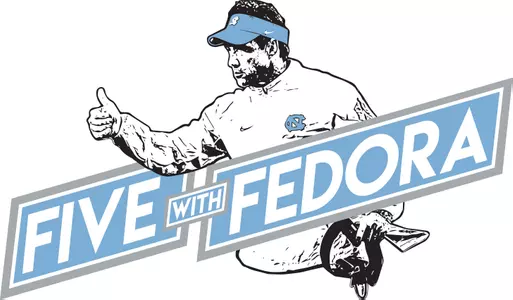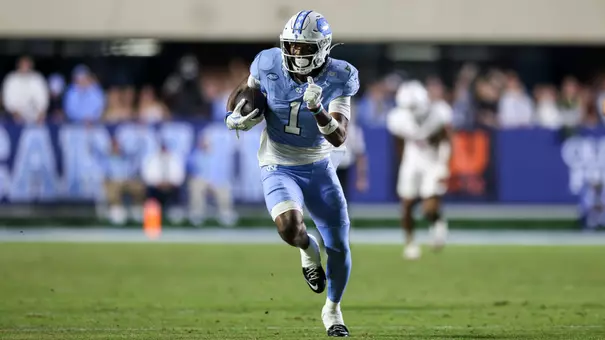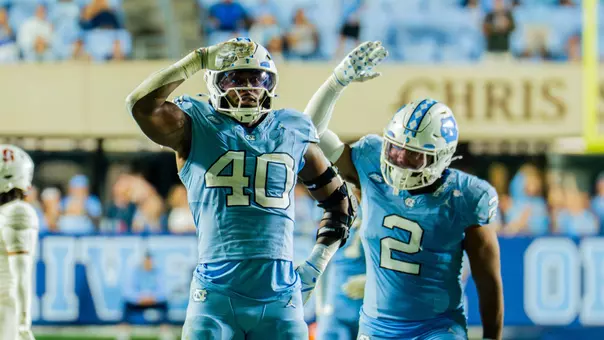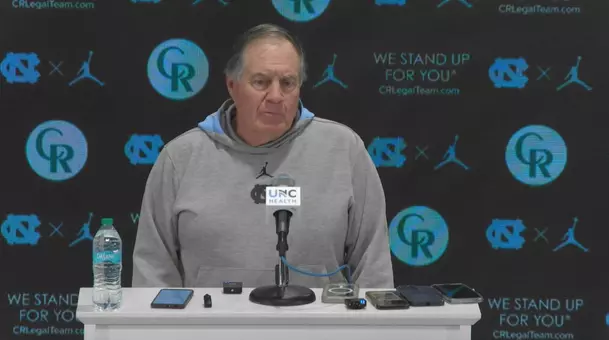University of North Carolina Athletics

Five With Fedora: Oct. 31
October 31, 2017 | Football
By Jeff Greenberg, GoHeels.com
1. Outside of the Old Dominion game, this was the defense's best performance in terms of limiting third down conversions; allowing Miami to convert only 4 out of 17 third downs, which was well below the defense's average on the season. Was it a schematic change that produced these results or more guys sticking to their assignments?
"One, JP did some specific scheming with the defense with this matchup that was effective in disrupting what they were trying to do. In addition to the scheme I would say the biggest factor in this game for us on defense was the front four guys. I think those guys played as well as they've played all year. They were very physical and played a huge part in forcing them into long-yardage situations. We forced them into around 15 third-and-long situations. The usual amount for one game is about seven of those situations. Just like on offense, where getting production on first and second downs helps prevent long-yardage situations on third down, the defense was able to force Miami into these situations because of how efficient we were on first and second down. A big part of that was holding them to 1.8 yards per rush. I think they had 59 total yards rushing after averaging around 160 to 170 yards per game this season. Their longest run was an 18-yard gain on a bootleg by the quarterback. Outside of than run they had 41 yards on 31 carries. If you can't run the ball effectively you will end up in long-yardage situations and that's what we were able to do to their offense. Again, I give a lot of credit to our guys up front causing a lot of havoc against a very good and very big offensive line."
2. On offense, you guys had ten different players with a reception which was a season high after averaging about five to seven guys in previous games. What was the key to getting more guys involved in this game?
"Actually, the answer to that is pretty simple. I thought Nathan Elliott did a great job of just taking what the defense gave him and getting the ball to whoever was in the right spot for that play. But he had to read that and make the decisions needed to do that. Things aren't just designed for one guy out there on any particular play. You'll have a first read you hope you can get to, but if that's not there then you have to go through the progression to the next guys. Another factor in so many guys catching passes was the fact that we had 92 plays on offense in this game. One guy can't play 92 snaps and with our depth issues right now we had to cycle a lot of guys in and out of this game. In normal situations, we really don't want any one receiver to play more than 50 snaps. So Gunter had to play more guys and you had somebody like Beau Corrales step up and make some plays when he got the opportunity to do so on the field. The offense was able to do more things in this game overall."
3. Speaking of them doing more things, your offense had more than 400 yards of total offense in a game for the first time since the Old Dominion game. What were you guys doing to generate that production?
"Our guys were more multi-dimensional this week. We made more plays, but we were able to make them in the run game, the passing game and the quarterback was able to do a lot with his legs as well. Miami has a really good front seven on defense and I thought our guys held their own and were able to move the ball consistently. I've said it before but when you move the chains on first and second down, it sure does make it easier to get more first downs. Our goal for this game was to have ten explosive plays on offense and we generated twelve of those plays in the game, which may be the most we've had this season. So the production was there. However, when you shoot yourself in the foot the way we did with four turnovers, you make it hard to win a game, regardless of what else the offense has done. That's what we have to eliminate in order to start winning games like this one where we played well enough to win the game."
4. This wasn't just any game either when you look at the opponent. It's hard to win any game but you were going up against the No. 8 team in the nation and went toe-to-toe with them until the end. Do your players see how close they were and what was their mindset like on Sunday when you met with them?
"I told them we are close. In most of our games this year we've been a few plays away from turning the outcome in our favor. I know they felt like that in the locker room after this game. Before I had to say a word they were telling each other that that was a game they could have won. So what's encouraging to see is that they believe they're right there. They believe they can turn the corner. That's why you see the closeness with this group. They want so badly to win for the guy next to them. What they're realizing now is that in addition to keep practicing hard, they have to pay attention more to the details that will help prevent them from making the mistakes that are costing us a win at the end of the game. They're learning that the details have to be as important to them on Tuesday and Wednesday as they are on Saturdays. That's hard sometimes for the younger guys to understand, and that has an impact on us because we are playing so many young guys now. But hopefully after a game like this one they can see how close we really are to turning the corner if we focus on the details it takes to play a complete game."
5. That references a concept that may be hard for the average spectator to see and understand because they aren't at practice every day or on the sidelines during a game. Young players have to learn how to be a college football player on every play, not just most plays. What effect has that dynamic had on the team and the coaching staff this season?
"Honestly, all you have to do is look across the country and see that there's only maybe a handful of freshmen that are able to contribute week in and week out. It just doesn't happen very often at this level. The simple reason is that there is a learning curve for freshmen and even redshirt freshmen. Most of these guys were stars at their high schools. They didn't have to really compete either to be the best at their school or in their area because they were better athletically than most or all of their competition. Then they get to college and they have to complete against guys who were stars at their high schools too. It's a mental grind to compete every day against guys who are just as good and just as hungry as you are. Doing the little things right and doing those little things over and over every day can be taxing on the younger players. Some kids mature faster through that learning curve than others, but you have to bring all of them along regardless of where they are in that development. Unfortunately, we've had to throw guys into the fire that maybe weren't completely ready for the moment. But we don't have a choice, and getting every one of those guys to the level we need them to be sooner than expected is easier said than done. Right now the focus is continually on getting each one of them to see their potential when they play their absolute best and give fanatical effort on every play. This game was another step in the right direction for some of our guys, and we need to build on that and get some more guys to that level."
1. Outside of the Old Dominion game, this was the defense's best performance in terms of limiting third down conversions; allowing Miami to convert only 4 out of 17 third downs, which was well below the defense's average on the season. Was it a schematic change that produced these results or more guys sticking to their assignments?
"One, JP did some specific scheming with the defense with this matchup that was effective in disrupting what they were trying to do. In addition to the scheme I would say the biggest factor in this game for us on defense was the front four guys. I think those guys played as well as they've played all year. They were very physical and played a huge part in forcing them into long-yardage situations. We forced them into around 15 third-and-long situations. The usual amount for one game is about seven of those situations. Just like on offense, where getting production on first and second downs helps prevent long-yardage situations on third down, the defense was able to force Miami into these situations because of how efficient we were on first and second down. A big part of that was holding them to 1.8 yards per rush. I think they had 59 total yards rushing after averaging around 160 to 170 yards per game this season. Their longest run was an 18-yard gain on a bootleg by the quarterback. Outside of than run they had 41 yards on 31 carries. If you can't run the ball effectively you will end up in long-yardage situations and that's what we were able to do to their offense. Again, I give a lot of credit to our guys up front causing a lot of havoc against a very good and very big offensive line."
2. On offense, you guys had ten different players with a reception which was a season high after averaging about five to seven guys in previous games. What was the key to getting more guys involved in this game?
"Actually, the answer to that is pretty simple. I thought Nathan Elliott did a great job of just taking what the defense gave him and getting the ball to whoever was in the right spot for that play. But he had to read that and make the decisions needed to do that. Things aren't just designed for one guy out there on any particular play. You'll have a first read you hope you can get to, but if that's not there then you have to go through the progression to the next guys. Another factor in so many guys catching passes was the fact that we had 92 plays on offense in this game. One guy can't play 92 snaps and with our depth issues right now we had to cycle a lot of guys in and out of this game. In normal situations, we really don't want any one receiver to play more than 50 snaps. So Gunter had to play more guys and you had somebody like Beau Corrales step up and make some plays when he got the opportunity to do so on the field. The offense was able to do more things in this game overall."
3. Speaking of them doing more things, your offense had more than 400 yards of total offense in a game for the first time since the Old Dominion game. What were you guys doing to generate that production?
"Our guys were more multi-dimensional this week. We made more plays, but we were able to make them in the run game, the passing game and the quarterback was able to do a lot with his legs as well. Miami has a really good front seven on defense and I thought our guys held their own and were able to move the ball consistently. I've said it before but when you move the chains on first and second down, it sure does make it easier to get more first downs. Our goal for this game was to have ten explosive plays on offense and we generated twelve of those plays in the game, which may be the most we've had this season. So the production was there. However, when you shoot yourself in the foot the way we did with four turnovers, you make it hard to win a game, regardless of what else the offense has done. That's what we have to eliminate in order to start winning games like this one where we played well enough to win the game."
4. This wasn't just any game either when you look at the opponent. It's hard to win any game but you were going up against the No. 8 team in the nation and went toe-to-toe with them until the end. Do your players see how close they were and what was their mindset like on Sunday when you met with them?
"I told them we are close. In most of our games this year we've been a few plays away from turning the outcome in our favor. I know they felt like that in the locker room after this game. Before I had to say a word they were telling each other that that was a game they could have won. So what's encouraging to see is that they believe they're right there. They believe they can turn the corner. That's why you see the closeness with this group. They want so badly to win for the guy next to them. What they're realizing now is that in addition to keep practicing hard, they have to pay attention more to the details that will help prevent them from making the mistakes that are costing us a win at the end of the game. They're learning that the details have to be as important to them on Tuesday and Wednesday as they are on Saturdays. That's hard sometimes for the younger guys to understand, and that has an impact on us because we are playing so many young guys now. But hopefully after a game like this one they can see how close we really are to turning the corner if we focus on the details it takes to play a complete game."
5. That references a concept that may be hard for the average spectator to see and understand because they aren't at practice every day or on the sidelines during a game. Young players have to learn how to be a college football player on every play, not just most plays. What effect has that dynamic had on the team and the coaching staff this season?
"Honestly, all you have to do is look across the country and see that there's only maybe a handful of freshmen that are able to contribute week in and week out. It just doesn't happen very often at this level. The simple reason is that there is a learning curve for freshmen and even redshirt freshmen. Most of these guys were stars at their high schools. They didn't have to really compete either to be the best at their school or in their area because they were better athletically than most or all of their competition. Then they get to college and they have to complete against guys who were stars at their high schools too. It's a mental grind to compete every day against guys who are just as good and just as hungry as you are. Doing the little things right and doing those little things over and over every day can be taxing on the younger players. Some kids mature faster through that learning curve than others, but you have to bring all of them along regardless of where they are in that development. Unfortunately, we've had to throw guys into the fire that maybe weren't completely ready for the moment. But we don't have a choice, and getting every one of those guys to the level we need them to be sooner than expected is easier said than done. Right now the focus is continually on getting each one of them to see their potential when they play their absolute best and give fanatical effort on every play. This game was another step in the right direction for some of our guys, and we need to build on that and get some more guys to that level."
Players Mentioned
UNC Women's Basketball: Tar Heels Battle Past Fairfield, 82-68
Sunday, November 16
UNC Wrestling: Heels Hold Off Navy, 20-18
Sunday, November 16
Hubert Davis post-NC Central Press Conference
Saturday, November 15
Carolina Insider: Rapid Reactions – Men’s Basketball vs. NC Central – November 14, 2025
Saturday, November 15
















